“CNC milling for plastic parts has changed the popularity of plastic applications across industries. Think about it: what used to take hours to hand-carve in plastic can now be done in one minute with an accuracy of less than 0.01 millimeters. Before, achieving such precision with plastics was thought impossible because of how flexible the material is. But with the rise of CNC milling, making detailed designs on plastic has become as doable as metal.”
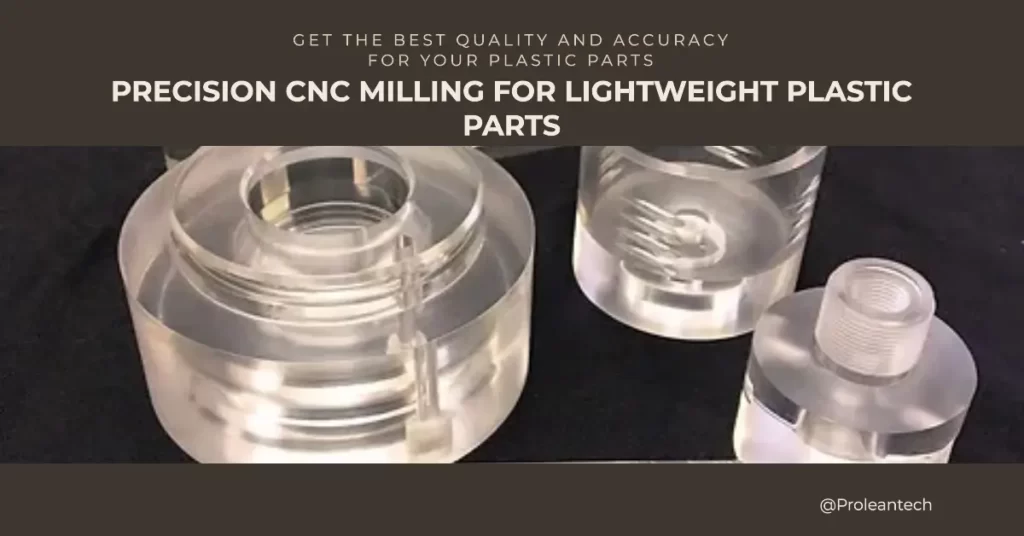
Looking closer, it’s clear that CNC milling for plastics isn’t just about machines doing the work. It’s about creative minds using technology to bring out the best in a material that used to be so tricky to work with. This article will discuss the nuances of CNC milling for plastic parts, required tools & parameters, benefits, applications, and tips & tricks.
The Fundamentals: CNC Milling for Plastic Parts
CNC (Computer Numerical Control) milling is a technology that uses computerized controls to move and operate milling machines, which can carve, cut, and shape materials into desired shapes & geometry. While metals like steel and aluminum have long been processed using CNC milling, plastics have joined the ranks in recent years, offering diverse advantages.
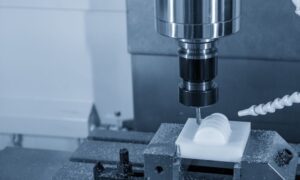
CNC milling for plastic parts
Plastic is a versatile material by nature. Its lightweight, corrosion-resistant, machinability, and mold-ability make it a favorite for many industries. Plastic is everywhere, from everyday items like toothbrushes and containers to specialized parts in the automotive or medical industry. But why is there a need to mill plastic when it can be molded?
Why do Plastics Need to be Machined?
Molding is fantastic for mass production, but it has limitations. The molds themselves can be expensive to produce, especially for intricate designs. Also, once a mold is made, altering it becomes a costly affair. However, manufacturers can create complex and precise parts without the need for molds with CNC milling technology. If there’s a need for design modifications, it can be done quickly by altering the digital design, saving time and resources.
- High Precision: Some applications demand extremely tight tolerances and intricate detailing, for example, medical & aerospace parts. CNC milling provides an accuracy that is often hard to achieve with conventional plastic forming methods.
- Complex Geometries: Plastic CNC milling can create parts with complex geometries, sharp angles, and detailed features that would be nearly impossible with just molding.
- Hard-to-shape plastic: While plastics are generally flexible and malleable, certain types are tougher and more rigid. Milling ensures that even these hard-to-shape plastics are crafted into the desired form without compromising the detail or accuracy.
Why Specialized Plastic CNC Milling Matters?
Plastics have secured prominence in manufacturing due to their versatility, adaptability, and cost-effectiveness. However, when it comes to shaping and detailing these materials, specialized plastic milling stands out. This process plays an irreplaceable role, ensuring that the final product is not just functional but also meets the exact specifications required.
To understand why Let’s delve deeper into its advantages and the unique challenges it addresses to know how specialized plastic milling holds significance in manufacturing.
1. Precision and Intricacy
Plastic milling using CNC machines brings a level of precision that’s hard to rival. When we compare this to traditional plastic shaping methods, the difference in the finished product’s accuracy is stark. Especially in industries like aerospace or medical devices, where a minor discrepancy can lead to significant repercussions, the precision of CNC milling becomes crucial.
2. Flexibility in Design Changes
One of the standout benefits of plastic milling is its adaptability. Traditional methods like molding, restrict design alterations once the initial mold is created. On the other hand, modifying a design is as simple as tweaking the digital blueprint with CNC milling, .This not only saves time but also reduces costs related to alterations.
3. Material Conservation
While plastic is relatively more affordable than metals, efficient material use is always a priority for manufacturers. Specialized plastic milling ensures minimal waste, thanks to its exact carving methods. This contrasts with methods where chunks of material might be discarded post-shaping.
Table: Comparison of Specialized Plastic Milling with Traditional Methods
| Feature | Specialized Plastic Milling | Traditional Methods |
|---|---|---|
| Precision | High | Moderate to Low |
| Flexibility for Design Modifications | Yes | Limited |
| Material Conservation | Optimal | Variable |
| Suitable for Complex Geometries | Yes | Often not |
4. Speed and Efficiency
CNC milling for plastics drastically reduces the time to produce parts, especially when you need intricate designs. The ability of these machines to work tirelessly also means that the production rate is consistent and fast.
5. Capability to Handle Diverse Plastics
Plastics come in many types. Some are soft like polyethylene, while others are hard like polycarbonate. Specialized plastic milling has the ability to handle this wide spectrum, ensuring that irrespective of the plastic type, the final product is impeccable.
6. Meeting Industry Standards
Many industries have stringent standards for parts, especially those used in critical applications. The plastic CNC milling is well-equipped to meet the exacting criteria of aerospace, automotive, medical, and many more industries that require parts that adhere to specific tolerances and standards.
For example, medical devices demand ISO 9001. ISO 9001 for the general standard and it’s an easy task for CNC milling.
Try Prolean Now!
Do You Need Specialized Tools in CNC Milling for Plastic Parts?
CNC milling requires specific tools to ensure precision, and efficiency, and to mitigate potential material damage. Using the correct tooling is crucial in achieving the desired results. Let’s explore some of these specialized tools, understanding their roles and benefits in the milling process for plastics.
Single-Fluted End Mills
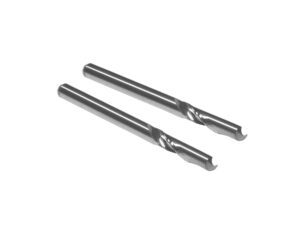
Single-fluted end mill
Single-fluted end mills, specifically designed for this purpose, ensure that plastics don’t melt during the milling process. The unique design of these mills provides a balance between up-cut and down-cut milling, promoting cleaner finishes. As a result, they are particularly suitable for soft plastics, preventing any material distortion during the process.
Diamond Cut End Mills
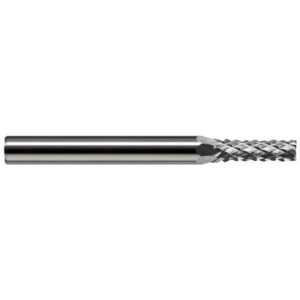
Diamond cut end mill
Plastics, especially those that are, present unique challenges. Diamond-cut end mills, with their sharp cutting edges, are ideal for these materials. Their design ensures smooth cuts, reducing the possibility of delamination or fraying. Moreover, these tools can also tackle more challenging plastics, which might be abrasive or tough.
Compression Cutters

Compressor cutters
Working with laminated plastics requires a tool that can prevent the top layer from peeling. Compression cutters, designed with both up-cut and down-cut flutes, are perfect for this role. Their design ensures that the cutting forces meet in the middle of the material, preserving the surface integrity on both sides of the laminated plastic.
Ball Nose End Mills
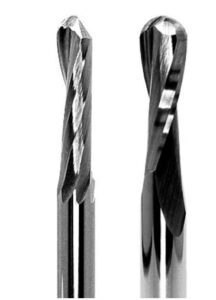
Ball nose end mills for plastic milling
Ball nose end mills are the go-to tool for intricate details or where smooth contours are needed. They have a rounded tip that allows for precision work, especially in 3D milling applications. This makes them ideal for creating detailed plastic parts often required in industries such as automotive or consumer electronics.
Plastic Engraving Tools
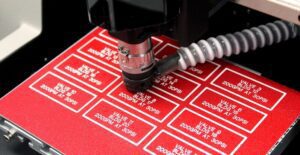
CNC engraving of plastic
Certain applications require engraving on plastic parts for information, branding, or decorative purposes. Plastic engraving tools, specifically designed with acute cutting angles and fine tips, allow for detailed work. They provide crisp and clear engravings without damaging the plastic substrate.
Table: Tool Characteristics for Plastic CNC Milling
| Tool | Preferred Scenario | Types of Plastics | Applications |
|---|---|---|---|
| Single-Fluted End Mills | Efficient chip removal | Soft plastics like PE, LDPE | General milling, product casings |
| Diamond Cut End Mills | Fiber-reinforced material milling | Reinforced plastics, PEEK | Aerospace, automotive components |
| Compression Cutters | Laminated plastic milling | Laminated sheets, PCBs | Electronics, signage |
| Ball Nose End Mills | Detailed work, smooth contours | ABS, Polycarbonate | Automotive trims, toy modeling |
| Plastic Engraving Tools | Detailed engraving | PVC, Acrylic | Branding, Information display, Decorations |
| O-Flute End Mills | Smooth finishes | Acrylic, ABS | Display cases, optical components |
| V-bit Cutters | Precise engraving | PVC, Polystyrene | Circuit boards, control panels |
| Up-cut End Mills | Effective chip evacuation | HDPE, LDPE | General milling, packaging tools |
| Down-cut End Mills | Clean top surface finish | PET, Polystyrene | Enclosures, containers |
| Roughing End Mills | Rapid material removal | Polypropylene, Nylon | Bulk material removal, initial part shaping |
Plastic CNC Milling Vs. Molding
In the manufacturing industry, two dominant techniques stand out for shaping plastics: CNC Milling and Molding. CNC Milling, a subtractive process, relies on computerized controls to operate and manipulate machine tools that cut and shape plastic materials. On the other hand, Molding is an additive process where molten plastic is injected into a mold, then cooled and solidified into the desired shape.
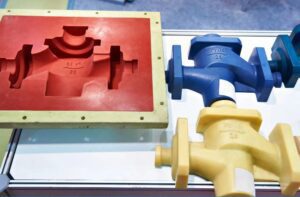
Plastic molding
Both methods offer unique advantages, often tailored to the project’s specific needs. While CNC Milling provides unparalleled precision and flexibility, especially for complex designs, Molding stands out for its efficiency and cost-effectiveness in large-scale productions.
Table: CNC Milling Vs. Molding
| Feature | CNC Milling | Molding |
|---|---|---|
| Process Type | Subtractive | Additive |
| Flexibility | High (easier design alterations) | Moderate (requires mold changes) |
| Material Waste | Variable (depends on design) | Minimal |
| Production Speed | Suitable for low to medium volumes | Faster for high volumes |
| Cost Effectiveness | More cost-effective for short runs | More cost-effective for bulk production |
| Precision & Tolerance | Very high (often up to 0.01mm) | Dependent on mold quality |
| Design Complexity | Ideal for intricate designs | Limited by mold design |
| Material Range | Broad range of plastics | Specific plastics, depending on the mold material |
| Set-Up Time | Faster for initial setup | Lengthier due to mold preparation |
| Tooling Investment | Lower initial tooling cost | Higher due to mold fabrication |
| Scalability | Scalable but may require multiple machines | Easily scalable with multiple mold replicas |
Try Prolean Now!
Machining Parameters: CNC Milling for Plastic Parts
Machining parameters serve as the blueprint for the CNC milling process, governing how the machine interacts with plastic materials. These parameters ensure that the milled part mirrors its digital design while optimizing efficiency, minimizing wastage, and safeguarding the tools from unnecessary wear. Essentially, these parameters form a bridge, translating digital aspirations into tangible, high-quality plastic components.
The pivotal machining parameters in CNC Milling for plastics encompass:
- Cutting Speed (Vc): Reflects the pace at which the tool’s cutting edge engages with the plastic workpiece. Typically expressed in meters per minute (m/min), the suitable speed varies with the plastic type.
- Spindle Speed (n): Denotes the rotation speed of the milling tool or cutter, often measured in revolutions per minute (RPM). It relates directly to the cutting speed and tool diameter.
- Feed Rate (f): Represents the speed at which the cutter progresses through the plastic material. It’s typically gauged in millimeters per tooth (mm/tooth).
- Depth of Cut (ap): The depth the tool penetrates the plastic in a singular pass.
- Width of Cut (ae): The width of the tool’s engagement on the plastic workpiece.
- Coolant Flow Rate: Although plastics generate less heat than metals, controlling temperature with coolants can prolong tool life and improve finish quality.
- Tool Path Strategy: This directs the predetermined route the tool will trace, influencing both machining time and the eventual surface finish.
Table: Machining Parameters in CNC Milling for Various Plastics
| Plastic Type | Cutting Speed (Vc) m/min | Spindle Speed (n) RPM | Feed Rate (f) mm/tooth | Depth of Cut (ap) mm | Width of Cut (ae) mm | Coolant Flow Rate ml/min | Tool Path Strategy |
|---|---|---|---|---|---|---|---|
| ABS | 200-500 | 4000-8000 | 0.02-0.04 | 2-5 | 1-4 | 50-150 | Climb milling |
| Polycarbonate (PC) | 100-300 | 2000-5000 | 0.01-0.03 | 1-4 | 0.5-2.5 | 100-200 | Conventional milling |
| PEEK | 80-250 | 1800-4800 | 0.02-0.04 | 2-5 | 1-3 | 50-150 | Climb milling |
| Polyethylene (PE) | 100-400 | 2500-6000 | 0.03-0.05 | 3-7 | 1-4 | 40-120 | Conventional milling |
| PVC | 50-250 | 1500-5000 | 0.02-0.04 | 2-6 | 1-3 | 60-160 | Climb milling |
| PMMA (Acrylic) | 150-450 | 3500-7000 | 0.02-0.05 | 2-6 | 1-4 | 70-180 | Conventional milling |
| PTFE (Teflon) | 70-200 | 1600-4500 | 0.02-0.04 | 2-5 | 1-3 | 50-140 | Climb milling |
| Nylon | 100-350 | 2400-5800 | 0.03-0.05 | 3-7 | 1-4 | 40-130 | Conventional milling |
| HDPE | 90-330 | 2200-5600 | 0.02-0.05 | 2-6 | 1-4 | 45-135 | Climb milling |
| Polypropylene (PP) | 110-370 | 2600-6200 | 0.03-0.05 | 3-7 | 1-4 | 50-140 | Conventional milling |
(Note: Values in this table are derived from various resources (1, 2, & formulae with hypothetical scenarios) and can deviate based on specific equipment and tool quality. As always, consulting with experts and performing tests are recommended.)
Applications of CNC Milling for Plastic Parts
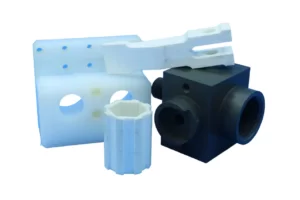
CNC-milled plastic parts
CNC milling has revolutionized the production and prototyping of plastic parts, marrying precision with scalability. Industries across the board have adopted this technology, leveraging its advantages to produce intricate and durable components that stand up to rigorous use.
Table: Applications of CNC Milling for Plastic Parts
| Industry | Why Preferred | Examples |
|---|---|---|
| Medical | Biocompatibility and precision for sensitive applications. | Surgical tools, implants, prosthetics. |
| Electronics | Accuracy for fitting within compact spaces. | Enclosures, connectors, circuit housings. |
| Aerospace | Lightweight and strength requirements. | Instrument panels, interior components. |
| Automotive | Durability and adaptability for diverse needs. | Dashboards, interior panels, light covers. |
| Consumer Goods | Mass production with consistent quality. | Toys, household gadgets, storage systems. |
| Defense | Reliability in harsh conditions. | Equipment casings, protective gear. |
| Food Industry | Non-toxicity and ease of cleaning. | Packaging systems, conveyor components. |
| Robotics | Precision and repeatability for complex assemblies. | Joints, casings, robotic limbs. |
| Energy | Resistance to varying conditions. | Insulation parts, battery casings. |
| Telecommunications | Precision and insulation capabilities. | Junction boxes, cable housing. |
| Marine | Corrosion resistance and lightweight. | Instrument housings, buoy components. |
These industries reflect just a fraction of the breadth of CNC milling covers in plastic parts fabrication. Its versatility continues to foster innovation across sectors.
Best Tips & Tricks for Plastic CNC Milling
As we discussed, plastics have unique properties compared to metals and with the right techniques and considerations, you can achieve excellent results, ensuring a smooth milling process and high-quality end products. The following are the key tips you can adopt according to milling scenarios for optimum results.
Tips for Efficient Plastic CNC Milling:
- Right Tool Selection: Opt for tools with sharper edges and larger relief angles to reduce friction and prevent plastic from melting.
- Optimized Feed Rates: Adjust feed rates to avoid excessive heat generation, which can deform the plastic or cause it to melt.
- Effective Chip Evacuation: Regularly remove chips to avoid re-cutting and heat accumulation, which can affect the workpiece’s quality.
- Limiting Tool Engagement: Reduce the tool’s engagement with the material to prevent excessive heat and ensure a smooth finish.
- Proper Cooling Methods: Use compressed air or specific coolants compatible with plastics. It helps in heat dissipation and avoids deformation.
- Fixture Considerations: Ensure effective clamping without causing stress points, which might lead to deformation or breakage.
- Opt for Single Flute End Mills: These allow better chip evacuation and reduce heat generation during the milling process.
- Depth of Cut: Avoid deep cuts that can produce excessive heat or stress. Multiple shallow passes might be more efficient.
- Machining Dry: Some plastics are better machined dry, without any coolant, to prevent any adverse reactions or deformations.
- Account for Material Expansion: Plastics tend to expand more than metals with temperature changes, so account for potential expansion in your design and milling parameters.
Get Your CNC-milled Plastic Parts at Prolean
Prolean stands as an industry leader when it comes to precision, quality, and reliability in CNC-milled plastic components. Our state-of-the-art facilities, combined with a team of experienced professionals, ensure that every project is handled with the utmost care and attention to detail.
Our commitment to excellence and customer satisfaction is evident in every part we produce. Whether you need intricate designs, tight tolerances, or large-scale productions, our advanced CNC milling service are tailored to meet your unique requirements, delivering unparalleled results every time.
Choosing Prolean means opting for impeccable quality, timely deliveries, and a partner who values your project’s success as much as you do. Trust Prolean for all your CNC-milled plastic part needs, and experience the difference of working with the best in the business.
Summing Up
CNC milling has emerged as a prominent manufacturing technique for plastic parts. As industries increasingly demand intricate designs, precise tolerances, and high-quality finishes, the role of CNC milling becomes pivotal. Not only does it surpass traditional methods in terms of precision, but it also offers remarkable flexibility, allowing design alterations without incurring hefty costs.
From aerospace to medical sectors, the applications of CNC-milled plastic parts are vast and varied, attesting to its versatility. Moreover, with the right machining tool, parameters, and operation, the efficiency of CNC milling for plastic parts can be maximized.
Read more: Why Small-batch CNC Machining is an Advantage for Your Business?
FAQs
What plastics are best for CNC milling? Acrylic, Nylon, and PTFE are among the top choices due to their machinability and desired properties.
How does CNC milling for plastics differ from metals? Plastics require careful temperature management to avoid melting, while metals demand tools capable of withstanding higher cutting forces.
Can CNC milling achieve intricate designs on plastics? Absolutely. With the right tooling and settings, intricate designs are achievable.
Is CNC milling for plastics cost-effective? Given its precision and reduced waste, it often proves more cost-effective than traditional methods.
How does Prolean stand out in metal CNC milling? Prolean combines advanced technology with skilled professionals, ensuring top-notch metal CNC milling results.
Are there any safety concerns when milling certain plastics? Some plastics can release fumes when milled. Proper ventilation and safety equipment are paramount.
References
1, https://www.tandfonline.com/doi/abs/10.1080/2374068X.2016.1143216

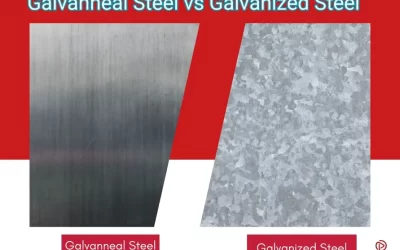

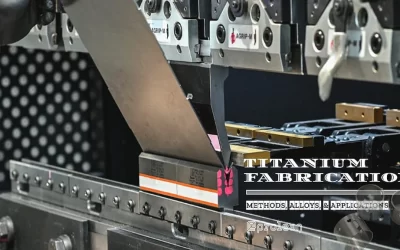
I have in working on plastic product design for 10+ years and i like how you provide comprehensive content on how to transfer design into actual product
Thanks for your words! Then you know , transferring design into actual product is combination of Technology and expertise
I have developed prototypes for Internal Computer Assembly parts with injection molding and CNC milling and of course the prototype with CNC was way better.
Yes Even injection molding is suitable and you does not need much accuracy, prototyping with CNC is way better.
Loved it ! How you present the plastic machining parameters in tabular form. But, as a mechanist i want to say that the values are pretty much differ for particular requirement of plastic machining project.
Thanks for your words! And by the way, yes” values could be pretty much differ for particular requirement of plastic machining project.” since it depend on your specific requirements.
It’s fascinating to see how precision and flexibility in design are achieved with CNC milling, making it an essential technology in modern manufacturing.
It’s indeed a fascinating field, continuously evolving with technological advancements. If you have any specific questions or need further information on implementing CNC milling in your projects, feel free to reach out to us